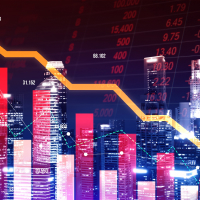Investment Insights
New Zealand Fixed Income Monthly – April 2023
As New Zealand’s current tightening cycle started about 19 months ago, it can already be said to be mature. It also follows that the full impact of the monetary policy decisions taken so far should now be building in the economy.
Balancing Act-Monthly insights: Multi-Asset Team-May 2023
Currently, we believe that valuations look stretched (mainly in the US) and volatility too low to justify that a new bull market is at hand, given the plethora of risks. We remain constructive on China's recovering demand and new sources of tech growth, but we are cautious for now for the relative complacency that appears not to adequately discount the eventually weaker economic data ahead and now renewed regional bank stress, and perhaps a US debt ceiling battle in the making.
A fundamental change for AI?
As the exponential growth of machine learning kicks in, we believe that big technology companies with the first mover advantage in AI and high-end manufacturers of AI-focused hardware and microprocessors, notably Asian players, are in a position of advantage.
New Zealand Equity Monthly – April 2023
New Zealand’s equity market was surprisingly strong in the first four months of 2023 given the current challenges faced by the economy. The actual picture is more mixed, however, partly as a result of the concentrated nature of the New Zealand market.
Navigating Japan Equities: Monthly Insights from Tokyo (May 2023)
This month we discuss how Warren Buffett’s focus on Japan has put the country’s market back on investor radars and how it could be a chance for companies to disseminate meaningful information; we also analyse the TSE’s surprise “name and shame” tactic with listed companies.
Financials, healthcare and energy buck the trend and rise in a down market.
Balancing Act-Monthly insights: Multi-Asset Team-April 2023
Market dynamics have changed quite considerably since mid-March after the regional bank failures in the US, which were quickly followed by turmoil at Credit Suisse leading to the bank’s forced marriage with UBS. The government response was swift and significant, and while central banks have attempted to message a somewhat normal return to its tighter policy agenda, markets simply are not buying it.
Asia’s healthcare opportunities
In Asia, where healthcare innovation and investment are borne from a critical need, the region’s healthcare industry today is where its technology industry was in the 2000s, meaning that a decade of investment is beginning to bear fruit.
Against a backdrop of a more stable bond market, we prefer relatively higher-yielding Philippine, India and Indonesian government bonds. In addition, there appears to be early signs suggesting that inflationary pressures in these countries have likely peaked, which we see providing further support for these bonds. As for currencies, we expect the Thai baht and Indonesian rupiah to outperform regional peers.
In a world starved of workers and growth, we believe that Asia’s ability to supply both puts the region on a very firm footing over the longer term. Once we get through this current US-led rate tightening cycle and the flush out of weaker financial institutions in the West, we see a bright future for Asia, which is now trading at extremely attractive valuations.
Navigating Japan Equities: Monthly Insights from Tokyo (April 2023)
This month we discuss how potential market volatility still bears watching even if the global banking turmoil may not directly shake Japan; we also assess how a steady domestic demand recovery may be in sight even if the public is slow to remove their masks after the recent easing of restrictions.
Consumption in Asia from a new perspective
Asia’s consumption trends were once thought to be heavily influenced by those in the West, but that is no longer the case. Asian consumers have diverse tastes and influences and they are starting to dictate global trends instead of merely absorbing them. We believe that Asian brands are well placed to respond to this new paradigm.
Resilience and attractiveness of Asian local bonds
Asian local currency bonds are expected to thrive as the region’s central banks end their rate hike cycle on the back of easing inflation. We believe that strong fundamentals, high-quality yields and limited foreign ownership are other factors that are supportive of this fixed income asset class.
Balancing Act-Monthly insights: Multi-Asset Team-March 2023
Investors have been dealing with elevated volatility in asset prices since the pandemic began. A contributing factor that continues to muddy the waters has been the volatility in economic data due to COVID-led distortions. In more recent months, particularly in the US, unseasonal weather patterns have made reading the economic tea leaves even more difficult.
Global Investment Committee’s Outlook
We expect fairly rough sailing for the global economy, financial system and markets in the next two quarters, but we do not expect disasters and there should be major relief for stocks later in 2023 as central banks begin to ease policy.
Global banking turmoil from an Asian perspective
It could be some time before the market stabilises in the wake of the global banking turmoil, and investor appetite toward financial subordinated debt will likely be weak in the near term. That said, considering the current valuations of fundamentally stronger Asian banks, we believe that a large part of such concerns are already reflected in their spreads/price following the re-pricing which took place earlier in March.
Asian financials: beyond the drama
Asian banks will be more insulated from the current global banking turmoil, in our view, thanks to smaller-scale rate hikes in Asia, prudent supervision by regional financial regulators, outsized capital adequacy ratios and sensible security exposure relative to total assets. We believe this will bode well for the sector in the longer term and enhance its attractiveness.
New Zealand Equity Monthly – February 2023
Bonds have been attracting more attention from investors recently in view of their higher yields and the possibility of capital gains. In addition, as equities have lost their shine for now amid higher interest rates, bonds are expected to continue to benefit from an asset allocation perspective.
New Zealand Fixed Income Monthly – February 2023
Bonds have been attracting more attention from investors recently in view of their higher yields and the possibility of capital gains. In addition, as equities have lost their shine for now amid higher interest rates, bonds are expected to continue to benefit from an asset allocation perspective.
Countries in the region took divergent monetary paths during the month. India and the Philippines raised their respective policy rates, while Indonesia and South Korea maintained their interest rates.
Net zero made in Asia
We believe that there are substantial rewards for those who are capable of driving the push for global decarbonisation. So, the question is: who is building the kit for the world’s net zero ambitions? We believe that the answer, both now and well into the future, is Asia.
Navigating Japan Equities: Monthly Insights from Tokyo (March 2023)
This month we discuss what the market may initially seek the most from the next Bank of Japan governor; we also look at Japan’s expanding outlays, with tax revenue and inflation in focus.
Thoughts on the 2023 China National People’s Congress
The official GDP growth target of “around 5%” unveiled at China’s annual National People’s Congress was lower than many external forecasts, and fiscal policy looks less accommodative relative to both market expectations and that of 2022. In our view, these conservative targets leave room for outperformance and likely reflect cautiousness over unexpected events and reluctance in overstimulating the economy.
The MSCI AC Asia ex Japan Index slumped 6.8% in US dollar terms, giving up its January gains. China’s reopening and peak interest rates euphoria in January were short-lived as hotter-than-expected economic indicator releases in the US raised the spectre of higher-for-longer interest rates.
Today’s surgical robot, tomorrow’s robot surgeon
Considered to be one of the greatest modern-day medical breakthroughs, robotic surgery is revolutionising surgical practices around the world. The breakthrough is particularly prominent in China, which could be the next growth frontier for surgical robotic companies.
The just-released 4Q CY22 data on aggregate corporate profits in Japan was somewhat mixed, as the overall corporate recurring pre-tax profit margin fell from its record high on a four quarter average. The non-financial service sector ticked up, but the manufacturing sector fell from its record high.
Global Equity Quarterly (Q4 2022)
Current equity market conditions dictate that you choose your investment attire particularly carefully. In our view, buying profitless technology companies is like going up a Scottish mountain wearing flip-flops. You might get away with it, but the odds are not in your favour. Instead, we prefer the protection afforded by profits (and cash) generated today—not at some unspecified point in the future.
Thoughts on the BOJ you might not have heard, but should consider
Currently, there is a wide variety of predictions for the BOJ’s actions, with some expecting imminent hawkish decisions based upon some of Governor-nominee Kazuo Ueda’s “anti-distortion” comments, but changes are more likely to be gradual and tentative assuming the global economy continues improving.
We maintain the view that global inflationary pressures may moderate further. We prefer Singapore, South Korea and Indonesia bonds. As for currencies, we favour the renminbi, the Singapore dollar and the Thai baht.
Balancing Act-Monthly insights: Multi-Asset Team-February 2023
Growth prospects look to be improving—a sharp shift from late 2022 when the markets had strong conviction that a first half slowdown was to be followed by a better second half.
Asian equities made a strong start to 2023, with the MSCI AC Asia ex Japan Index returning 8.2% in US dollar (USD) terms in January, supported by a rebound in investor sentiment towards China.
Japan Value Insights: CDMOs and health-related social needs
Contract development and manufacturing organisations (CDMOs) could play an important role in addressing health-related needs as society seeks rapid solutions to issues such as an increase in refractory diseases.
Navigating Japan Equities: Monthly Insights from Tokyo (February 2023)
This month we assess the trends in wages and salaries with significant change potentially in progress; we also discuss how changes at the BOJ may affect the market.
Balancing Act-Monthly insights: Multi-Asset Team-January 2023
In our view, the change from dollar strength to relative weakness is meaningful for the shift in relative growth prospects, favouring the rest of the world over the US.
Consumption potential in China’s lower-tier cities
While consumer sentiment may be weaker across China presently, we believe that the long-term outlook for the country’s consumer sector remains attractive. China’s lower-tier cities are stepping up to fuel the growth engine that once relied heavily on megacities.
Clean, secure and affordable energy is likely to be one of the major challenges of this decade. Given we need abundant energy to complete the energy transition, we believe fossil fuel companies that are actively enabling transition to low carbon society can be part of the solution. They often understand how to deliver global energy at scale and have the balance sheets capable of enabling the transition to clean energy.
Chinese shares outperformed in December as the country continued to move away from its zero-COVID policy while markets in Taiwan and South Korea slumped amid concerns towards the global economy. In ASEAN, Thailand led the region as the country is expected to be one of the biggest beneficiaries of a potential return of Chinese tourists.
We expect global inflation to ease and global growth to weaken in 2023; we also think that the Fed is likely to pause hiking rates by the first quarter of 2023. Against this backdrop, we are broadly constructive on regional bonds as most Asian central banks could be nearing the end of their rate hike cycles.
Navigating Japan Equities: Monthly Insights from Tokyo (January 2023)
We discuss the Bank of Japan’s unexpected move to tweak its yield curve control scheme and the potential implications; we also provide a brief overview of some of the factors seen impacting Japan equities in 2023.
Global Investment Committee’s Outlook
We don’t expect smooth sailing for the global economy and markets, but there should be great relief for both stocks and bonds in 2023, with pockets of strong outperformance due to idiosyncratic advantages. Notably, Europe and Developed Pacific-ex Japan should be overweighed for equites for the next six months, but Japan should perform the best by next December.
On the Ground in Asia-Monthly Insights: Asian Fixed Income-November 2022
We are more positive on duration overall, on the assessment that we are likely past peak hawkishness from the Federal Reserve and other developed market central banks. We favour Singapore and South Korean government bonds, given their relatively higher sensitivity to stabilising US Treasury yields.
Balancing Act-Monthly insights: Multi-Asset Team-December 2022
While we do not expect the US Federal Reserve to pivot any time soon towards easing policy, the firm break in dollar momentum perhaps reflects a shift in the relative growth story which had favoured the US towards one focused on the rest of the world centred around improving China demand.
BOJ’s YCC shift parallels a Fed pattern
In what was probably the best kept secret of many years, the BOJ unanimously agreed to shift its YCC policy well before virtually any economist or market watcher expected. The largest question people seem to have is “why now?”. As with most major decisions, the answer was likely a confluence of several important items.
Asian stocks rebounded strongly in November after Federal Reserve Fed Chair Jerome Powell pointed to slower pace of monetary policy tightening and lifted market sentiment. All Asian markets ended in positive territory, with China in the lead with a month-on-month (MoM) gain of 29.7%.
New Zealand Fixed Income Monthly – November 2022
Although New Zealand’s November 2022 rate hike was larger than expected, markets had been pricing in aggressive tightening for quite some time. This may soften the impact of the current challenges. Given that yields on some bonds are now approaching 6%, we feel that stronger income generation opportunities are also providing a silver lining in the fixed income market.
2023 Asian equity outlook
As we look towards 2023, it is easy to be overwhelmed by the broader permutations of possible outcomes. But things don’t appear so dire in Asia. Inflation, which is effectively a value transfer from net consumers to net producers, may continue to benefit India and pockets of ASEAN due to favourable demographics and rising productivity.
Navigating Japan Equities: Monthly Insights from Tokyo (December 2022)
This month we discuss the prospects of Japanese equities remaining well-supported into 2023 thanks to robust exports and inbound demand. We also explain why the markets are looking beyond a dip in Japan’s 3Q GDP, focusing instead on the prospect of growth resuming.
New Zealand Equity Monthly – November 2022
The cost of living and the cost of doing business are still weighing down on New Zealand’s consumers and companies as the end of 2022 approaches. On the corporate side, New Zealand’s companies continue to grapple with wage inflation driven by a scarcity of workers, higher logistics costs amid lingering supply chain issues, and elevated interest costs as hikes in the Official Cash Rate continue to bite.
2023 Japan equity outlook
As geopolitical risks and globalisation are reassessed in the wake of the COVID-19 pandemic and war in Europe, we believe that Japan stands to benefit as more companies refocus on their home markets.
2023 New Zealand fixed income outlook
New Zealand’s Official Cash Rate and short-term interest rates may stay elevated in 2023 but longer-term interest rates are likely to decline starting in the second half of the year as financial markets begin pricing in the possibility of rate cuts. Falling rates could see a stabilisation of the housing market and an improving outlook for the economy and financial market returns.























































